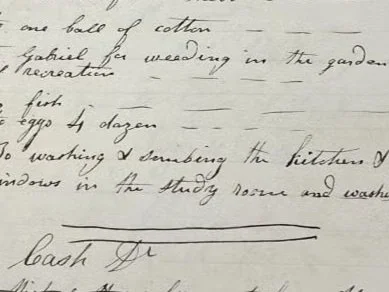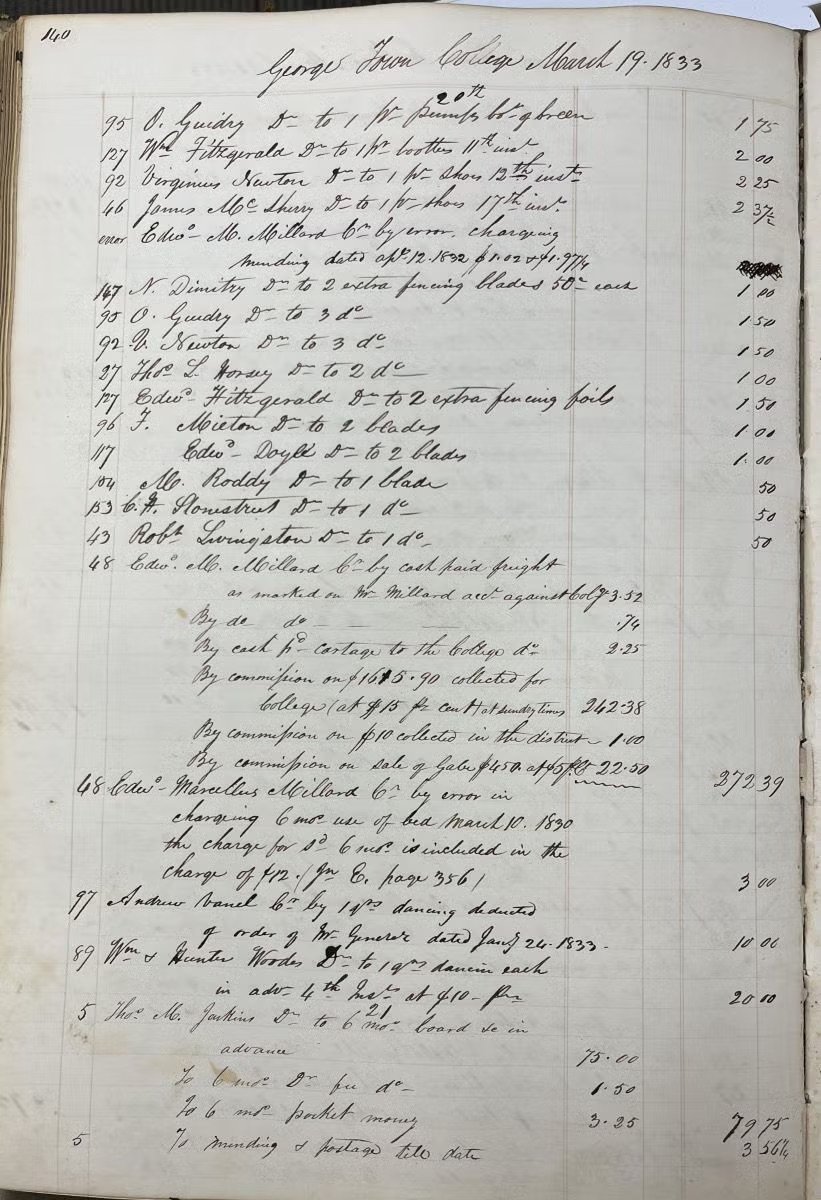Gabriel Dorsey
This narrative was composed by Mr. Ed Donnellan, who teaches social studies at Gonzaga College High School in Washington, D.C. Gonzaga College High School students, Julie Bernier, Ph.D., and Jennie K. Williams, Ph.D. contributed to this research.
Gabriel Dorsey’s name first appears in an accounting leger from the Washington Seminary, a Catholic boys school in Washington, DC that was the founding institution for Gonzaga College High School. The line in the ledger is from April 30, 1822 and says, “To Gabriel for weeding in the garden in time of recreation.” Gabriel was paid “6 ¼ the same amount the school paid for “a ball of cotton.” Gabriel appears two more times in the ledger. On October 18, 1824 the notation says, “To Gabriel” and the payment was $0.20. The final time that Gabriel found at the Washington Seminary is from January 26, 1825. He is now called “Gabe” and the payment was $0.12.
An October, 1827 entry from a Georgetown College ledger provides many details about Gabriel, “Mrs. Margaret Fenwick by Hillary’s wages from May 1, 1825 (Hillary arrived at the college at about the end of April, 1825) to the 13th of October 1827 (When Gabe a black boy from the Seminary of Washington took Hillary’s place) at $1.00 off month. Gabriel’s enslaver was Margaret Fenwick, a wealthy Washington DC widow who was receiving a discount on her son’s tuition in return for Gabriel’s unpaid labor.
A year later Gabriel was offered a chance to purchase his freedom. The arrangement required him to pay Fenwick “$8.00 a month for the opportunity to contract himself out. He could then set aside any remaining money, “until he collects $400.”
On May 17, 1829 Margaret Fenwick died. Her eldest son Benedict was a Jesuit priest and now became the owner of Gabriel. Just thirty days later on June 18, 1829 the Jesuits sold Gabriel to James Franklin Purvis for $450. Purvis was an agent for the slave trading firm, Franklin and Armfield. Two days later on June 20, 1829 a document was signed by witnesses who describe Gabriel as “about twenty-one years of the male sex, about 5 feet 3 inches’ high, a black man of complexion.” They also stated. “that they had known the said slave named Gabriel in the forgoing certificate mentioned for several years, and that he not, within their knowledge, been guilty of convicted of any crimes, but that he has a good moral character, and is not in the habit of running away.” The document was signed by Anthony McCelroy, brother of John McElroy, SJ, Joshua Millard, parent of Washington Seminary and Georgetown College student Edward Millard, Richard McSherry brother of John McSherry, SJ and James Franklin who represented Franklin and Armfield. This document was required before and enslave person could be sold in New Orleans.
On November 6. 1829 Gabriel and 171 other enslaved persons including infants, was marched from a slave pen on Duke St in Alexandria and taken to the Potomac River waterfront where he was put on a ship, The United States. About three weeks later the ship arrived in New Orleans. Upon his arrival in New Orleans Gabriel was described as “a negro of light complexion aged twenty-one years.” He was valued at $700.
Gabriel appears in the Georgetown College archives on final time on March 20, 1833, “By commission for sale of Gabe for $450. at %5…$22.50.” The payment was put into the account of Edward Millard, whose father was likely being paid for his role as a witness to the sale of Gabriel in 1829.
-
This was the first of several entries found by Gonzaga student researchers that document the use of the slave hiring system by the Jesuits of the Washington Seminary. Gabriel Dorsey -- always recorded without his surname -- received of a tip of 6 1/4¢ on August 22, 1822, for weeding in the garden of Washington Seminary. The students later learned that the Jesuits paid Margaret Fenwick wages for the work performed by him.
-
Shortly before Washington Seminary ended its operations, on October 13, 1827, the Jesuits of Georgetown College hired Gabriel Dorsey out, paying $1 per month to his owner Margaret Fenwick. On that date, they also ended their agreement to hire out Hillary, a woman also owned by Fenwick who had worked for the College since May 1, 1825.
-
Gabe “obtained leave to buy himself free.” Under the arrangement recorded on March 31, 1828, Gabe would pay $8 monthly until he had saved $400, when he would be freed. Such agreements helped enslavers establish obedience and loyalty.
-
On June 18, 1828, Georgetown College received $450 from Mr. Purvis, an agent of the slave traders Franklin & Armfield, for the sale of Gabe. His enslaver Margaret Fenwick had passed away one month earlier, on May 17. Instead of honoring the terms of self-purchase, her heirs the Jesuits initiated a transaction that ended with his transport to New Orleans.
-
This is the manifest of the voyage that carried Gabriel Dorsey from Alexandria, VA to New Orleans. You can read more about records like this one here.
-
The Jesuits continued to profit from the sale of Gabriel Dorsey as late as March 19, 1833. The fee for the services of Joshua Millward, who served as an agent in the sale, were credited toward the student account of his son Edward M. Millard, as noted in the cash book “by commission for the sale of Gabe $450 at 5[%] . . . $22.50.”
-
This is a Freedman’s Bureau record from Tensas Parish, Louisiana. It is difficult to know for certain without additional sources, but the individual listed on this document as “Gabe Dorsey” may be the Gabriel Dorsey who began his life in Maryland.







